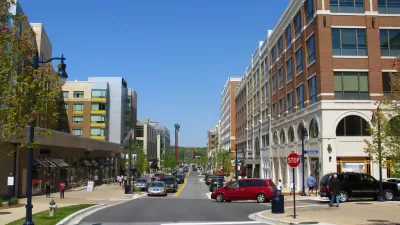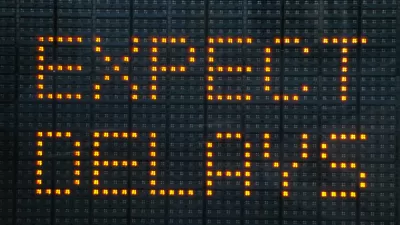The newest Texas Transportation Institute Urban Mobility Report was recently released, stimulating discussion of congestion costs and potential solutions. Here are some things you should know when evaluating these issues.
The newest Texas Transportation Institute Urban Mobility Report was recently released, stimulating discussion of congestion costs and potential solutions. Here are some things you should know when evaluating these issues.
There are many several possible ways to measure congestion costs. The method used by the Texas Transportation Institute leads to relatively high cost values, since it assumes that "optimal" roadway conditions are freeflow (level-of-service A), although many transportation economists consider this assumption is inappropriate (see for example, the 2006 report, Costs of Non-Recurrent Congestion in Canada). They argue that congestion costs should be calculated above an optimal threshold, such as level-of-service C or D, which leads to significantly lower cost estimates.
There are also several congestion indicators. Roadway Level-of-Service ratings (the intensity of congestion delays on a particular roadway or at an intersection, rated from A to F, like a school grate) and the Travel Time Index (the ratio of peak period to free-flow travel times) indicate congestion delays experienced when people drive, but fail to account for differences in the amount of per capita peak-period driving that occurs in a community. For example, congestion tends to be relative intense in compact, multi-modal cities, but per capita congestion delays are relatively low, because, in such communities people make fewer and shorter automobile trips than in sprawled, automobile-oriented cities. Indicators that reflect per capita rather than per vehicle impacts are more suitable for evaluating overall congestion problems.
How does congestion compare with other transportation costs? Even using the TTI's relatively high estimates, which calcualtes that congestion costs total about $78 billion annually in the U.S., it is a medium-size cost, greater than noise pollution, about equal to air pollution, and less than roadway costs, parking facility costs, accidents and total vehicle costs. This suggests that a strategy that reduces traffic congestion by 20% would not be worthwhile if it caused even a 5% increase in parking costs, crash costs and vehicle ownership costs, but would be worth far more if it provides even modest reductions in these other impacts.

There are many possible ways to reduce traffic congestion, some of which tend to provide much greater overall benefits than others. Expanding urban highways may reduce congestion delays in the short run, but this benefit tends to decline over time due to generated traffic (additional peak-period vehicle trips stimulated by reduced congestion delays), a portion of which consists of induced travel (a total increase in vehicle travel). After a few years, congestion generally returns to its earlier level (that is, it maintains equilibrium, because congestion itself limits further increases in peak-period trips), while total regional vehicle travel increases due to induced travel and more sprawled land use. This induced travel increases many transport costs, including downstream congestion, road and parking facility costs, accidents, energy consumption and pollution emissions, and sprawl. Proponents often claim that expanding congested highways will reduce energy consumption and pollution emissions, but such benefits are generally short-lived, because reductions in per-mile impacts are soon offset by increases in total vehicle travel.
Other congestion reduction strategies avoid these costs, providing greater net benefits. For example, adding a lane to a congested suburban highway will typically accommodate about 2,000 additional suburban automobile commuters, adding 2,000 vehicles on surface streets, requiring 2,000 additional employee parking spaces, and increasing total accidents, energy consumption and pollution emissions, all costs that can be avoided if these commuters travel by alternative modes.
Which congestion reduction strategy is considered most efficient and cost effective often depends on how impacts are measured. An engineering perspective evaluates efficiency based on amount of traffic that can be accommodated. It considers a roadway inefficient if traffic volumes exceed a road's capacity, reducing the travel speeds and the number of vehicles that can be accommodated. An economic perspective also considers the value of travel. It recognizes that transport system efficiency can be increased if higher value trips have priority over lower value trips, and more efficient modes have priority over lower value modes. For example, roadway pricing allows freight vehicles, transit vehicles, and urgent trips to outbid lower-value trips for road space. This increases economic efficiency and gives travelers more options so they can choose the one that best meets their needs for each individual trip.
For example, with current pricing, travelers are equally delayed by congestion regardless of how they travel. With efficient pricing, on Monday and Wednesday you might choose to drive on unpriced lanes and face congestion; on Tuesday and Thursday you ride in a vanpool or ride on a bus in an uncongested High Occupant Toll (HOT) lane; and on Friday, you pay a toll to drive along on the uncongested lane (called value pricing). This is more efficient overall, because the system provides options from which you can choose the one that best fits your needs for each trip, and rewards you for choosing more resource efficient options (such as traveling by vanpool or public transit, which imposes less congestion per passenger-mile).
Unfortunately, the traffic and economic models used to evaluate congestion reduction options tend to overlook many of these factors, and so exaggerate the overall benefits of roadway capacity expansion, and undervalue alternative solutions. For example, when comparing traffic congestion reduction strategies, conventional economic evaluation does not account for the additional parking costs, accidents and emission costs that result from induced travel, and the saving provided strategies that reduce total vehicle travel. As a result, conventional planning practices lead to excessive investment in roadway capacity expansion, and underinvestment in alternative modes and mobility management strategies, compared with what is optimal.

Alabama: Trump Terminates Settlements for Black Communities Harmed By Raw Sewage
Trump deemed the landmark civil rights agreement “illegal DEI and environmental justice policy.”

Study: Maui’s Plan to Convert Vacation Rentals to Long-Term Housing Could Cause Nearly $1 Billion Economic Loss
The plan would reduce visitor accommodation by 25% resulting in 1,900 jobs lost.

Planetizen Federal Action Tracker
A weekly monitor of how Trump’s orders and actions are impacting planners and planning in America.

Waymo Gets Permission to Map SF’s Market Street
If allowed to operate on the traffic-restricted street, Waymo’s autonomous taxis would have a leg up over ride-hailing competitors — and counter the city’s efforts to grow bike and pedestrian on the thoroughfare.

Parklet Symposium Highlights the Success of Shared Spaces
Parklets got a boost during the Covid-19 pandemic, when the concept was translated to outdoor dining programs that offered restaurants a lifeline during the shutdown.

Federal Homelessness Agency Places Entire Staff on Leave
The U.S. Interagency Council on Homelessness is the only federal agency dedicated to preventing and ending homelessness.
Urban Design for Planners 1: Software Tools
This six-course series explores essential urban design concepts using open source software and equips planners with the tools they need to participate fully in the urban design process.
Planning for Universal Design
Learn the tools for implementing Universal Design in planning regulations.
Caltrans
Smith Gee Studio
Institute for Housing and Urban Development Studies (IHS)
City of Grandview
Harvard GSD Executive Education
Toledo-Lucas County Plan Commissions
Salt Lake City
NYU Wagner Graduate School of Public Service





























